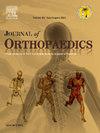Development of a personalized parametric finite element model of the knee: Evaluation of geometric variables affecting osteoarthritis progression
IF 1.5
Q3 ORTHOPEDICS
引用次数: 0
Abstract
Background
Osteoarthritis is a degenerative condition that impacts synovial joints, particularly the knee joint. Researchers regard Finite Element Analysis as a promising technique for managing knee osteoarthritis. However, these models often depend on input geometry from one or more individuals, feature complex interfaces, and require a significant amount of time, which makes them unsuitable for clinical use and reduces their reliability.
Purpose
This study aims to assess the effectiveness of the personalized parametric model technique in predicting the knee joint's mechanical response, taking into account anatomical variables that influence osteoarthritis.
Methods
A 3D model of the knee was created from CT images of a patient with knee osteoarthritis. Lateral, anterior, and posterior knee radiographs were obtained from twenty-six subjects to customize the geometric parameters of the developed parametric model. The knee geometry was parameterized using Ansys software. The models used six parameters to represent the articular surface of the tibial plateau, its slope, and variables attached to the medial and lateral femoral condyles. Parametric FE models were created individually by applying the ground reaction force diagram to each model.
Results
Mean maximum von Mises stress was higher in the OA group than in the control group. Simulations of the patients in the OA group indicated that the mean von Mises stress at the articular surfaces diminished with an increase in tibial plateau tilt. Also, individual geometry-specific models exhibited varying responses, thereby confirming the significance of taking personalized geometry into account.
Conclusion
Personalized models can be used to simulate mechanical responses and specifically evaluate the effect of the tibial plateau tilt. This work presented an innovative method for creating individualized finite element models of osteoarthritic knees, which can be used as a practical and effective tool in clinical environments.

膝关节个性化参数化有限元模型的发展:评估影响骨关节炎进展的几何变量
背景:骨关节炎是一种影响滑膜关节,尤其是膝关节的退行性疾病。研究人员认为有限元分析是治疗膝关节骨关节炎的一种很有前途的技术。然而,这些模型通常依赖于一个或多个个体的输入几何形状,具有复杂的界面,并且需要大量的时间,这使得它们不适合临床使用并降低了它们的可靠性。本研究旨在评估个性化参数模型技术在预测膝关节力学反应方面的有效性,同时考虑到影响骨关节炎的解剖学变量。方法对1例膝关节骨关节炎患者的CT图像进行三维建模。获得26名受试者的侧位、前位和后位膝关节x线片,以定制所开发的参数化模型的几何参数。采用Ansys软件对膝关节几何形状进行参数化。该模型使用六个参数来表示胫骨平台的关节面、其斜率以及附着在股骨内侧和外侧髁上的变量。将地面反力图应用于各模型,分别建立参数化有限元模型。结果OA组平均最大von Mises应力高于对照组。骨性关节炎组患者的模拟显示,关节表面的平均von Mises应力随着胫骨平台倾斜的增加而减小。此外,个别几何模型表现出不同的响应,从而证实了将个性化几何考虑在内的重要性。结论个性化模型可用于模拟胫骨平台倾斜的力学反应,并对其影响进行针对性评价。这项工作提出了一种创新的方法来创建个体化的骨关节炎膝关节有限元模型,可以作为临床环境中实用有效的工具。
本文章由计算机程序翻译,如有差异,请以英文原文为准。
求助全文
约1分钟内获得全文
求助全文
来源期刊

Journal of orthopaedics
ORTHOPEDICS-
CiteScore
3.50
自引率
6.70%
发文量
202
审稿时长
56 days
期刊介绍:
Journal of Orthopaedics aims to be a leading journal in orthopaedics and contribute towards the improvement of quality of orthopedic health care. The journal publishes original research work and review articles related to different aspects of orthopaedics including Arthroplasty, Arthroscopy, Sports Medicine, Trauma, Spine and Spinal deformities, Pediatric orthopaedics, limb reconstruction procedures, hand surgery, and orthopaedic oncology. It also publishes articles on continuing education, health-related information, case reports and letters to the editor. It is requested to note that the journal has an international readership and all submissions should be aimed at specifying something about the setting in which the work was conducted. Authors must also provide any specific reasons for the research and also provide an elaborate description of the results.
 求助内容:
求助内容: 应助结果提醒方式:
应助结果提醒方式:


